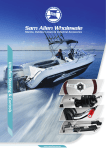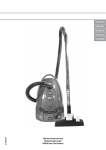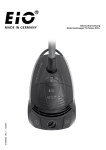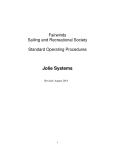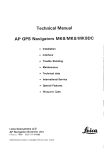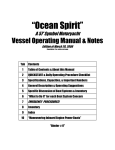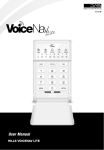Download INSTALLATION GUIDE - Type S & T Dashboard Mechanical Drive
Transcript
POWERBOAT SYSTEMS TYPE S & TYPE T DASHBOARD DRIVES INSTALLATION MANUAL OC15270 REV D 30 NOV 2012 Revision History Revision D Description Redesign in booklet © 2012 Octopus Products Inc. All rights reserved. The information contained in this document is the sole property of Octopus Products Inc. Any reproduction in part or whole without the written permission of Octopus Products Inc. is prohibited. Octopus Products Inc will nor be liable for errors contained herein or for incidental or consequential damages in connection with the furnishing, performance or use of this document. Subject to change without notice 2 of 40 OC15269 REV E WWW.OCTOPUSDRIVES.COM WWW.OCTOPUSEUROPE.COM CONTENTS A A1 A2 A3 B B1 B2 B3 B4 B5 B6 B7 C C1 C2 D D1 D2 Introduction System Overview . . . . . . . . . . . . . . . . . . . . . . . . . . . . . . . . . . . . . . . . . . . . 4 Compatibility Information . . . . . . . . . . . . . . . . . . . . . . . . . . . . . . . . . . . . . . . 4 Important Safety Features . . . . . . . . . . . . . . . . . . . . . . . . . . . . . . . . . . . . . 5 A3a Manual Release . . . . . . . . . . . . . . . . . . . . . . . . . . . . . . . . . . . . . . . 5 A3b Manual Override . . . . . . . . . . . . . . . . . . . . . . . . . . . . . . . . . . . . . . 5 Mechanical Installation Available Space - Physical Envelope & Orientation . . . . . . . . . . . . . . . . . . 6 Cable Compatibility . . . . . . . . . . . . . . . . . . . . . . . . . . . . . . . . . . . . . . . . . . . 7 B2a Morse 304411-xxx or Teleflex SSC52-xx . . . . . . . . . . . . . . . . . . . 7 B2b Teleflex SSC61-xx or Teleflex SSC62-xx . . . . . . . . . . . . . . . . . . . 7 B2c Uflex M66-xx . . . . . . . . . . . . . . . . . . . . . . . . . . . . . . . . . . . . . . . . . 8 B2d Morse 304415-xxx, Teleflex SSC72-xx or Uflex M47-xx . . . . . . . .8 Type S Straight Shaft Drive . . . . . . . . . . . . . . . . . . . . . . . . . . . . . . . . . . . . 9 B3a Mounting Kits . . . . . . . . . . . . . . . . . . . . . . . . . . . . . . . . . . . . . . . . . 9 B3b Fitting The Drive Unit . . . . . . . . . . . . . . . . . . . . . . . . . . . . . . . . . . 10 B3c Spacer Kits . . . . . . . . . . . . . . . . . . . . . . . . . . . . . . . . . . . . . . . . . 14 Type T Tilt Steering Drive . . . . . . . . . . . . . . . . . . . . . . . . . . . . . . . . . . . . . 15 B4a Mounting Kits . . . . . . . . . . . . . . . . . . . . . . . . . . . . . . . . . . . . . . . . 15 B4b Fitting The Drive Unit . . . . . . . . . . . . . . . . . . . . . . . . . . . . . . . . . . 15 B4c Spacer Kit . . . . . . . . . . . . . . . . . . . . . . . . . . . . . . . . . . . . . . . . . . 19 Replacing Steering Cable . . . . . . . . . . . . . . . . . . . . . . . . . . . . . . . . . . . . . 20 B5a Cable Length Calculation . . . . . . . . . . . . . . . . . . . . . . . . . . . . . . 20 B5b Running New Steering Cable . . . . . . . . . . . . . . . . . . . . . . . . . . . 21 Rudder Feedback Unit (RFB) Installation & Calibration . . . . . . . . . . . . . . 22 B6a Universal RFB Setup . . . . . . . . . . . . . . . . . . . . . . . . . . . . . . . . . . 22 B6b Calibration & Installation . . . . . . . . . . . . . . . . . . . . . . . . . . . . . . . 23 Friction Brake . . . . . . . . . . . . . . . . . . . . . . . . . . . . . . . . . . . . . . . . . . . . . . 24 Electrical Installation Connecting Drive To Autopilot . . . . . . . . . . . . . . . . . . . . . . . . . . . . . . . . . 25 Rudder Feedback Unit . . . . . . . . . . . . . . . . . . . . . . . . . . . . . . . . . . . . . . . 25 C2a Connection - non-Simrad Autopilots . . . . . . . . . . . . . . . . . . . . . . 25 C2b Connection - Simrad Autopilots . . . . . . . . . . . . . . . . . . . . . . . . . . 26 Appendix Accessories . . . . . . . . . . . . . . . . . . . . . . . . . . . . . . . . . . . . . . . . . . . . . . . . 27 General Maintenance Guide . . . . . . . . . . . . . . . . . . . . . . . . . . . . . . . . . . . 28 Subject to change without notice 3 of 28 OC15270 REV D WWW.OCTOPUSDRIVES.COM WWW.OCTOPUSEUROPE.COM A A1 INTRODUCTION System Overview The Octopus Type S and Type T Remote Drives are rotary mechanical autopilot drive systems which makes it simple and economical to fit an autopilot on smaller powerboats with mechanical push-pull cable steering. The drive units are suitable for standard straight shaft (Type S) or tilt-steering (Type T) configurations and incorporate a drive motor, solenoid clutch and integrated rudder feedback (RFB) capability. The compact drive units completely replace the existing manual steering helm and so are totally concealed behind the dash, giving a neat, professional installation. A2 Compatibility Information • The drives are recommended for use on boats with a maximum speed of 40mph (65km/h) and should not be fitted to boats which can exceed this. • The drives should not be fitted to boats where the engine max horsepower exceeds the max horsepower rating for the boat as stated on the boat manufacturer’s tag. • The drive unit either replaces or is used in conjunction with common brands of mechanical rotary and rack & pinion steering helm units. The drive is based on the Morse 290 rotary helm unit and accepts Morse 304411 and Teleflex SSC52 rotary cables without modification. If the boat is fitted with any of the following systems: Teleflex Safe T or Teleflex Big T Uflex T71, Uflex T73NR or Uflex T81 a cable adapter must be fitted to the cable before installing the drive. •If the boat has a rack and pinion type steering system (or other brands of rotary system), the drive can be used, but the steering cable must also be replaced with a Morse 304411 or Teleflex SSC52. • The drive is designed to produce a maximum cable push/pull of 300lbs (136kg), which makes it suitable for the vast majority of cable steered boats. However some boats fitted with push pull cable steering systems have very stiff steering or steering which is heavily loaded in one direction due to hull design and engine considerations. Generally speaking, the drive will steer boats that do not require more than a 15lb force on the rim of a 14in diameter steering wheel to hold a course, this equals 105in-lb of torque. If the steering wheel input torque exceeds this figure it is recommended that a hydraulic linear actuator drive system is used. •If the existing steering system is a NFB (non feed back) type, the Type S and T drives can be fitted, but it is strongly advised that the helmsperson is formally familiarized with the different operational characteristics of the new helm. Subject to change without notice 4 of 28 OC15270 REV D WWW.OCTOPUSDRIVES.COM WWW.OCTOPUSEUROPE.COM A3 Important Safety Features The helmsperson should be made aware of the two following safety features before using the Autopilot: A3a Manual Release The drive features a manual release in case the Autopilot is switched to manual mode by mistake, which could result in a dangerous manoeuvre or violent movement of the steering wheel on a powerboat due to propeller action or trim forces. While the drive is under consistent load from the boat’s steering system in one direction or no movement, the drive unit clutch will remain engaged when the Autopilot is switched to manual mode. To disengage the drive a small joggle action (turning the wheel/tiller from side to side) will release the clutch and allow manual control. IMPORTANT The helmsperson should always be ready to take manual control of the boat when the Autopilot is returned to manual mode. DOCKSIDE TESTING Due to the ‘Manual Release’ safety feature, when the boat is not in motion it might be necessary to joggle the wheel/tiller (move from side to side) to engage or disengage the drive. A3b Manual Override IMPORTANT It is STRONGLY advised that the helmsperson be familiarized with this manual override procedure before proceeding to sea. In the event of uncontrolled automatic steering or any other emergency situation where it is imperative that manual control be reassumed immediately, the helmsperson can override the steering action of the drive unit by exerting force on the steering wheel in the opposite direction to the drive. This action will cause the drive unit thrust limit to “slip” allowing the helmsperson to take control. NOTE The manual override does not disengage the autopilot - to resume full manual control the autopilot should be switched to standby as soon as is practically possible. Subject to change without notice 5 of 28 OC15270 REV D WWW.OCTOPUSDRIVES.COM WWW.OCTOPUSEUROPE.COM B MECHANICAL INSTALLATION When planning the installation, it is recommended that the following are considered: • Ensure there is adequate space available to accomodate the drive. • Determine the compatibility of the existing steering cable and select the appropriate cable adaptor if required. • Select the appropriate dashboard bezel kit and determine whether helm spacers are needed. • Determine whether any additional accessories are needed. B1 Available Space - Physical Envelope & Orientation The depth required behind the dashboard for the drive will vary slightly depending upon the drive type and mounting style used, but all require around 10in (250mm) clearance. If sufficient depth is not available it may be possible to re-route wiring harnesses or move components etc. Additional clearance can also be gained using spacers - see sections B3c (Type S) or B4c (Type T) for further details. TOP VIEW SIDE VIEW MIN 250mm (10in) clearance front-back (216mm / 8.5in with spacers) MIN 150mm (6.0in) clearance MIN 90mm (3.5in) MIN 115mm (4.5in) clearance clearance Fig B1 - Physical drive envelope Subject to change without notice 6 of 28 OC15270 REV D WWW.OCTOPUSDRIVES.COM WWW.OCTOPUSEUROPE.COM B2 Cable Compatibility The Type S and Type T drives are based on the Morse 290 rotary helm unit which accepts Morse 304411 and Teleflex SSC52 rotary steering cables. Cable adapters are available to accept rotary steering cables from other popular manufacturers. • If you are unsure of the make/model of steering cable fitted to the vessel, the part number and length of the cable is usually printed on the cable outer casing near to the tiller/engine connection. Using either the cable part number or by comparing the outer cable head detail with the diagrams in sections B2a - B2d, establish if a cable adapter is required. • If the existing steering system is a rack and pinion type then the steering cable must be replaced with a Morse 304411 or Teleflex SSC52 rotary steering cable, see section B5a for instructions on calculating the cable length. B2a Morse 304411-xxx or Teleflex SSC52-xx (x = length in feet) If the boat is fitted with either of these cable types then it can be connected directly to the Octopus drive - no cable adaptor is required. 2.5mm (0.1in) Fig B2 - Morse 304411 and Teleflex SSC52 steering cable B2b Teleflex SSC61-xx or Teleflex SSC62-xx (x = length in feet) Order cable adaptor OC15SUK08. 4mm (0.16in) OC15SUK08cable adaptor Fig B3 - Teleflex SSC61 or SSC62 steering cable with cable adaptor fitted Subject to change without notice 7 of 28 OC15270 REV D WWW.OCTOPUSDRIVES.COM WWW.OCTOPUSEUROPE.COM B2c Uflex M66-xx (x = length in feet) Order cable adaptor OC15SUK08. 4mm (0.16in) OC15SUK08cable adaptor Fig B4 - Uflex M66 steering cable with cable adaptor fitted B2d Morse 304415-xxx, Teleflex SSC72-xx or Uflex M47-xx (x = length in ft) Order cable adaptor OC15SUK07. OC15SUK07 cable adaptor Fig B5 - Morse 304415, Teleflex SSC72 or Uflex M47 steering cable with cable adaptor fitted Subject to change without notice 8 of 28 OC15270 REV D WWW.OCTOPUSDRIVES.COM WWW.OCTOPUSEUROPE.COM B3 Type S Straight Shaft Drive B3a Mounting Kits There are two dashboard mounting options compatible with the Octopus Type S drive system: • 90º Bezel Kit OC15SUK10: This kit should be used if the steering wheel is mounted 90º to the dashboard (Fig B6). Fig B6 - 90º mounting • 20º Bezel Kit OC15SUK09: This kit should be used if the steering wheel is mounted 20º to the dashboard (Fig B7). Fig B7 - 20º mounting Spacer kits are also available to reduce the space required behind the dashboard if required. See section B3c for further details. Subject to change without notice 9 of 28 OC15270 REV D WWW.OCTOPUSDRIVES.COM WWW.OCTOPUSEUROPE.COM B3b Fitting The Drive Unit • Remove the existing steering helm. i) Remove the steering wheel. ii) Unbolt and remove the helm unit*. If the existing steering is rack and pinion the pinion will need to be unbolted from the rack before it can be removed. * Depending on the boat layout and accessibility to the space behind the dashboard, it may be more convenient to remove the steering cable before unbolting the existing manual helm and to refit the steering cable after the Octopus drive has been mounted to the dashboard, rather than the order of installation given in these instructions. • Prepare dashboard to receive drive bezel plate. Refer to Fig B8 or use the bezel plate as a template for the mounting holes that will need to be drilled. i) Care must be taken not to damage any electrical wiring or throttle cables behind the dashboard when drilling - if necessary tape these out of the way temporarily. ii) If it is necessary to enlarge the existing steering shaft hole in the dashboard for the drive unit, clamp a piece of wood over the hole as a guide for the hole saw. This will ensure that the hole is cut accurately and the hole saw doesn’t jump while drilling, which could scratch or damage the dashboard. 62mm (2.43in) C 50mm (2.0in) B C A B 25mm (1.0in) 25mm (1.0in) 44.5mm (1.75in) 62mm (2.43in) A: Ø 82.5mm (3.25in) B: 3 x Ø 8.5mm (0.34in) 20º bezel kit only C: 2 x Ø 2.5mm (0.1in) B Fig B8 - Mounting holes for 90º and 20º bezel plates Subject to change without notice 10 of 28 OC15270 REV D WWW.OCTOPUSDRIVES.COM WWW.OCTOPUSEUROPE.COM • Fit the bezel plate to the dashboard (Fig B9). Dashboard i) Use the 3 x 5/16 nuts, bolts and washers supplied with the kits. Bezel plate ii) Ensure that the nuts, bolts and washers are fitted in the correct order - the washers should be between the nuts and the rear of the dashboard. iii)Do not fit the plastic bezel cover at this stage. Fig B9 - 90º bezel plate fitted to dashboard • Remove the steering cable from the helm unit (Fig B10). i) Make a careful note of both the orientation of the helm unit and which side of the helm that the cable is inserted - if this is refitted incorrectly the steering will work in reverse. ii) Unfasten the retaining bolt or locking nut (depending on cable type) at the cable entry port. iii)Pull the cable retaining collar away from the helm unit. iv)The inner cable can be wound out by turning the steering shaft (it may help if the wheel is refitted). Retaining bolt Steering cable outer jacket Retaining collar Fig B10 - Remove steering cable from existing manual helm Subject to change without notice 11 of 28 OC15270 REV D WWW.OCTOPUSDRIVES.COM WWW.OCTOPUSEUROPE.COM • Fit the steering cable (Fig B11). i) Fit cable adaptor to cable (if required). ii) Apply a thin coat of marine grade grease to the exposed section of the cable. iii) Insert the steering cable into the drive port. Using moderate force, guide the inner cable around the driving hub and out of the opposite port. Retaining collar iv)Push the cable jacket into the port until the retaining collar butts against the drive housing. Turn the steering shaft to wind the cable into the drive it may help to fit the wheel in order to do this. Cable entry port v) Insert lock bolt to hold cable in place. vi)If undue force is required to insert the cable, this may be caused by the end of the inner cable fouling the outer face of the nylon guide. If this is the case, remove the cable and inspect for sharp edges. If possible, twist the cable so that the sharp edge is towards the inside of the radius, or use a file or burr type tool to remove the sharp edges. Cable exit port Retaining bolts vii)Fit the spent cable tube to the opposite port and insert the lock bolt. viii)Fit washers & nuts to both lock bolts, tighten & torque to 40-45in-lbs (4Nm). Spent cable tube Fig B11 - Fitting steering cable and spent cable tube to drive unit Subject to change without notice 12 of 28 OC15270 REV D WWW.OCTOPUSDRIVES.COM WWW.OCTOPUSEUROPE.COM • Fit the drive unit to the dashboard. i) Position the drive unit behind the dashboard and bolt it to the bezel plate using the 3 x 1/4”. bolts supplied (Fig B12). Tighten and torque to 3-35in-lbs. ii) Fit the plastic cover* over the bezel plate. * This is a snap fit on the 90º bezel kit. The plastic cover on the 20º bezel kit is held in place using screws which fit the two additional holes drilled into the dashboard. iii)Insert the locating key (“Woodruff Key”) into the recess on the steering shaft and refit the steering wheel. Dashboard Bezel cover Fig B12 - Mounting drive unit to dashboard bezel plate • Check the installation i) Rotate the wheel fully from lock to lock to check that the steering works smoothly across its full range and that it is steering in the right direction. ii) If the rudder moves in the opposite direction to the wheel, the cable has been inserted into the drive unit the wrong way and needs to be inserted in the other port - swap the cable and take-up tube over. Subject to change without notice 13 of 28 OC15270 REV D WWW.OCTOPUSDRIVES.COM WWW.OCTOPUSEUROPE.COM B3c Spacer Kits If there is not the required 250mm (10in) clearance behind the dashboard for the Type S drive unit, this can be reduced with the use of spacer kits (Fig B13). • 90º Mount Spacer Kit OC15SUK16: This kit is for use in conjunction with the OC15SUK10 90º Bezel Kit only. Each spacer segment reduces the required depth by 19mm (0.75in) and a maximum of two spacer kits can be used on an installation for a maximum depth reduction of 38mm (1.5in). • 20º Mount Spacer Kit OC15SUK17: This kit is for use in conjunction with the OC15SUK09 20º Bezel Kit only. Each spacer segment reduces the required depth by 16mm (0.625in) and a maximum of two spacer kits can be used on an installation, for a maximum depth reductions of 32mm (1.25in). Spacer (one per kit) Fig B13 - Using spacer kits to reduce the required clearance behind the dashboard Subject to change without notice 14 of 28 OC15270 REV D WWW.OCTOPUSDRIVES.COM WWW.OCTOPUSEUROPE.COM B4 Type T Tilt Steering Drive B4a Mounting Kit The Octopus Type T drive package includes a dashboard mount bezel which is designed to connect to a Teleflex Performance Tilt mechanism (not supplied) A spacer kit is also available to reduce the space required behind the dashboard if required. See section B4c for further details. NOTE: Please contact Octopus Technical Support regarding retrofit components available for using the Type T drive with older Morse, Teleflex or Uflex tilt systems. Fig B14 - Tilt steering (TFX Performance Tilt Mechanism) B4b Fitting The Drive Unit • Remove the existing steering helm. i) Remove the steering wheel and the tilt mechanism. ii) Unbolt and remove the helm unit*. If the existing steering is rack and pinion the pinion will need to be unbolted from the rack before it can be removed. * Depending on the boat layout and accessibility to the space behind the dashboard, it may be more convenient to remove the steering cable before unbolting the existing manual helm and to refit the steering cable after the Octopus drive has been mounted to the dashboard, rather than the order of installation given in these instructions. • Refer to Fig B15 for the required hole centres to fit the tilt mechanism mounting plate. As the plate is designed to fit a standard TFX tilt mechanism the existing holes should be correct. 47mm (1.86in) B A: Ø 75mm (3.0in) B: 3 x Ø 6.5mm (0.26in) 23mm (0.91in) A B B 41.5mm (1.63in) 41.5mm (1.63in) Fig B15 - Mounting holes for modified tilt mechanism mounting plate Subject to change without notice 15 of 28 OC15270 REV D WWW.OCTOPUSDRIVES.COM WWW.OCTOPUSEUROPE.COM • Fit the modified tilt mechanism mounting plate supplied with the Type T drive to the dashboard (Fig B16). This part replaces the existing mounting plate which is discarded. Dashboard i) Use the 3 x 5/16in nuts, bolts and washers supplied with the kit. ii) Ensure that the nuts, bolts and washers are fitted in the correct order - the washers should be between the nuts and the rear of the dashboard. iii)Do not fit the tilt mechanism at this stage. Mounting plate Fig B16 - Tilt bezel plate fitted to dashboard • Remove the steering cable from the helm unit. i) Make a careful note of both the orientation of the helm unit and which side of the helm that the cable is inserted - if this is refitted incorrectly the steering will work in reverse. ii) Unfasten the retaining bolt or locking nut (depending on cable type) at the cable entry port. iii)Pull the cable retaining collar away from the helm unit iv)The inner cable can be wound out by turning the steering shaft (it may help if the wheel is refitted). Subject to change without notice 16 of 28 OC15270 REV D WWW.OCTOPUSDRIVES.COM WWW.OCTOPUSEUROPE.COM Retaining bolt Steering cable outer jacket Retaining collar Fig B17 - Remove steering cable from existing manual helm • Fit the steering cable (Fig B18). i) Fit cable adaptor to cable (if required). ii) Apply a thin coat of marine grade grease to the exposed section of the cable. iii) Insert the steering cable into the drive port. Using moderate force, guide the inner cable around the driving hub and out of the opposite port. iv)Push the cable jacket into the port until the retaining collar butts against the drive housing. Turn the steering shaft to wind the cable into the drive - it may help to fit the wheel in order to do this. v) Insert lock bolt to hold cable in place. Retaining collar Cable exit port Cable entry port Retaining bolt vi)If undue force is required to insert the cable, this may be caused by the end of the inner cable fouling the outer face of the nylon guide. If this is the case, remove the cable and inspect for sharp edges. If possible, twist the cable so that the sharp edge is towards the inside of the radius, or use a file or burr type tool to remove the sharp edges. vii)Fit the spent cable tube to the opposite port and insert the lock bolt. viii)Fit washers & nuts to both lock bolts, tighten & torque to 40-45in-lbs (4Nm). Subject to change without notice 17 of 28 Spent cable tube Fig B18 - Fitting steering cable and spent cable tube to drive unit OC15270 REV D WWW.OCTOPUSDRIVES.COM WWW.OCTOPUSEUROPE.COM • Fit the drive unit to the dashboard. i) Position the drive unit behind the dashboard and bolt it to the bezel plate using the 2 x 1/4x1.5 bolt supplied (Fig B19). Tighten and torque to 30-35in-lbs. ii) Fit the tilt mechanism to the bezel plate using the fixings supplied with the tilt mechanism. Tighten and torque to 30-35in-lbs. iii)Ensure the locating key (“Woodruff Key”) is fitted into the recess on the steering shaft and refit the steering wheel. Dashboard Tilt mechanism (not supplied) Fig B19 - Mounting drive unit to dashboard bezel plate • Check the installation i) Rotate the wheel fully from lock to lock to check that the steering works smoothly across its full range at all tilt angles and that it is steering in the right direction. ii) If the rudder moves in the opposite direction to the wheel, the cable has been inserted into the drive unit the wrong way and needs to be inserted in the other port - swap the cable and take-up tube over. Subject to change without notice 18 of 28 OC15270 REV D WWW.OCTOPUSDRIVES.COM WWW.OCTOPUSEUROPE.COM B4c Spacer Kit If there is not the required 250mm (10in) clearance behind the dashboard for the Type T drive unit, this can be reduced with the use of spacer kits (Fig B20). • Spacer Kit OC15SUK18: This kit is for use in conjunction with the Type T Drive bezel plate only. Each spacer segment reduces the required depth by 12.5mm (0.5in) and a maximum of two spacer kits can be used on an installation for a maximum depth reduction of 25mm (1.0in). Spacer (one per kit) Fig B20 - Using spacer kits to reduce the required clearance behind the dashboard Subject to change without notice 19 of 28 OC15270 REV D WWW.OCTOPUSDRIVES.COM WWW.OCTOPUSEUROPE.COM B5 Replacing Steering Cable Depending on the existing manual steering system fitted to the boat, it may be necessary to replace the steering cable with a type that is compatible with the Type S / Type T drive (either a Morse 304411-xxx or Teleflex SSC52-xx). Although the replacement cable will ideally follow the same route as the existing cable, for optimum steering performance - whether under autopilot or steering manually - consideration must be given to the following points: i) The chosen route should use the minimum possible number of bends. ii) If any bends are necessary, maximise the bend radius as much as possible. It is recommended that bends have a radius of no less than 6in (150mm) and that the combined total angle of all bends is no more than 270º. B5a Cable Length Calculation Use a length of rope or electrical cable to plan out the steering cable route and then measure the total length required (Fig B21) : (‘A’ Dimension + ‘B’ Dimension + ‘C’ Dimension) – 8in for 2 x 90º bend Round up the result to the nearest full foot size and then refer to section D1 for the appropriate custom cable order code. Dim D im en si on ‘A’ ‘B ’ Mid ens ion stro 6in (150mm) minimum radius ke ‘c’ n sio en m Di Subject to change without notice Fig B21 - Preferred cable routing 20 of 28 OC15270 REV D WWW.OCTOPUSDRIVES.COM WWW.OCTOPUSEUROPE.COM B5b Running New Steering Cable The accessibility of the steering cable run will depend on the size of the boat - on smaller boats the cable is usually easily accessible, but larger boats may run the cable through ducts that are more difficult to access. • Changing the cable will be easier if a tag line (or “mouse”) is attached to the end of the existing cable before it is removed. This can be used to pull the new cable through. • Use a strong line for the mouse that will not snap easily, but is thin enough to pass down the duct behind the cable. • Tie the mouse securely to the cable and use tape to reinforce the joint. Pull the cable through from the rudder end while feeding the mouse line from the steering end. When the old cable has been removed, attach the mouse to the new cable and use it to pull it back through from the rudder end. Attach the new cable to the steering arm of the boat by pulling out the cotter pin and clevis pin to release the old steering shaft and replacing it with the new steering shaft. Line up the shaft with the steering arm by turning the steering wheel and re-insert the cotter and clevis pins Fig B22. Fig B22 - Replacing steering cable - rudder end Subject to change without notice 21 of 28 OC15270 REV D WWW.OCTOPUSDRIVES.COM WWW.OCTOPUSEUROPE.COM B6 Rudder Feedback Unit (RFB) Installation & Calibration Most autopilots require a rudder feedback device which is usually attached directly to the rudder - this complicates installation in certain applications, particularly with sterndrive and outboard engined boats. They are often exposed to the elements and prone to damage due to ORDER CODE AUTOPILOT RESISTOR their location. The optional Rudder Feedback Unit is a simple solution which attaches directly to the drive unit itself and is calibrated using a simple procedure. A range of Rudder Feedback units are available which are compatible with most popular autopilot systems (Fig B23). OC15SUK27A COMNAV, SI-TEX 4k OC15SUK27B RAYMARINE 5k OC15SUK27D SIMRAD 3k OC15SUK27E FURUNO, TMQ, NAVMAN, GARMIN, COURSEMASTER, SI-TEX SP110 1k Fig B23 - Rudder feedback compatibility B6a Universal RFB Setup If a dedicated RFB is not available for a brand of autopilot, the OC15SUK27 Universal RFB should be suitable. This module is configured to the particular autopilot using DIP switch settings: AUTOPILOT DIPSWITCH RESISTOR** FURUNO, TMQ, NAVMAN, GARMIN, COURSEMASTER, SI-TEX SP110 1k RAYMARINE 5k SIMRAD* 3k COMNAV, SI-TEX 4k DIP Switch * Simrad autopilots also require Signal Conversion Module OC15SUK83 ** Fixed resistance measured between black and white wire. Resistance between white and black wire is variable Fig B24 - Universal RFB DIP Switch Settings Subject to change without notice 22 of 28 OC15270 REV D WWW.OCTOPUSDRIVES.COM WWW.OCTOPUSEUROPE.COM B6b Calibration and Installation The calibration routine should be performed after the drive unit has been fitted to the vessel and wired up to the autopilot. The RFB should also be electrically connected to the autopilot prior to calibration (refer to sections C1 and C2). i) Remove the RFB module from the drive housing (if already fitted) by removing the two fixing screws. ii) Center the rudder of the boat using the manual helm (you may need to run the engine to do this). iii)Calibrate the RFB by aligning the two red paint marks on the underside of the unit (Fig B25). iv)Remove the RFB blanking cap from the drive unit housing (Fig B26a). Align the two red dots Fig B25 - Calibrating the rudder feedback unit v) Fit the RFB to the drive housing and fix using the two screws provided (Fig B26b). Ensure that the RFB driven gear is correctly engaged with the drive gear before tightening the 2 screws. vi) Refer to the autopilot manufacturer’s installation guide for instructions on any additional software controlled RFB fine calibration and hardover limitation. Blanking cap Fig B26 - Installing the rudder feedback unit Subject to change without notice 23 of 28 OC15270 REV D WWW.OCTOPUSDRIVES.COM WWW.OCTOPUSEUROPE.COM B7 Friction Brake A friction brake allows the helmsman to adjust the steering friction to reduce the drift effect from prop wash or current while retaining a comfortable ‘tactile feel’ to the steering. A friction brake assembly is available that is compatible with the Type S straight shaft drive - order code OC15SUK11 (Fig B27). • The friction brake assembly should be fitted after the drive has been attached to the bezel plate, but before the plastic cover has been fitted (Fig B28). Fig B27 - Friction Brake Assembly i) Fit the brake ring over the steering shaft and push back as far as it will go. ii) Slide the clamp ring over the brake ring. Fit the clamp screw. iii) Fit the retaining ring over the steering shaft to hold the friction brake assembly in place. iv)Fit the plastic bezel cover and steering wheel. Brake Ring Clamp Ring Retaining Ring Clamp Screw Fig B27 - Fitting friction brake assembly to Type S drive Subject to change without notice 24 of 28 OC15270 REV D WWW.OCTOPUSDRIVES.COM WWW.OCTOPUSEUROPE.COM C ELECTRICAL INSTALLATION C1 Connecting Drive to Autopilot As the Type R Autopilot Drive is designed to work with most autopilot manufacturers’ equipment, the wiring colors or connection references will differ slightly in each case. However, drive to autopilot connections are fundamentally the same for all makes of autopilot. The Type R drive has a simple four wire connection - two wires are for the drive motor power feed, the other two are for the clutch (Fig C1). Refer to the autopilot manufacturer’s instructions for wiring information. DRIVE CABLE AUTOPILOT RED MOTOR +12V BLACK MOTOR -12V (0V) GREEN CLUTCH +12V WHITE CLUTCH -12V (0V) Fig C1 - Motor and clutch cable connections Note that the Type R drive requires a 12V input for both the motor drive and the clutch. Do not use with a 24V system. C2 Rudder Feedback Unit C2a Connection - non-Simrad Autopilots i) Connect the RFB Module wires to autopilot junction box - refer to Figs C2 and C3 for the correct wiring color connections for common autopilot brands. ii) Setup and calibrate the RFB as described in section B6. RFB RAYMARINE NAVMAN TMQ Fig C2 - RFB cable connections SI-TEX COURSECOMNAV GARMIN MASTER SP110 SP70/80 RED RED ORANGE RED ORANGE POWER RED +VE PIN 3 BLACK GREEN BLACK BLUE BLUE COMMON BLACK -VE PIN 1 WHITE BLUE BLUE GREEN BROWN WIP PIN 2 SHIELD SILVER BLACK BLACK N/A N/A N/A POSITION YELLOW N/A N/A Fig C3 - Rudder Feedback connections by manufacturer Subject to change without notice 25 of 28 OC15270 REV D WWW.OCTOPUSDRIVES.COM WWW.OCTOPUSEUROPE.COM C2b Connection - Simrad Autopilots The RFB Module OC15SUK27D MUST be used in conjunction with the Signal Conversion Module OC15SUK83 when integrating with Simrad Autopilots. i) IMPORTANT - all wiring connections must be made between the RFB Module, the Signal Conversion Module and the Autopilot Course Computer BEFORE powering up the Course Computer. Failing to follow this will result in the RFB signal not being recognized by the Course Computer. If this occurs perform the “Autopilot Reset” procedure (refer to Simrad autopilot manual). ii) Determine suitable site to mount the Signal Conversion Module. Shorten or insert suitable extension cable as required to suit the installation. iii)Connect the RFB Module, Signal Conversion Module and Autopilot Course Computer together as shown in Fig C4. Use a marine grade electrical connection strip and ensure the wires are properly insulated and protected. iv)Connect Octopus Signal Conversion Module output wires to Auto Pilot Junction Box following Auto Pilot installation and wiring diagram. v) Setup and calibrate the RFB as described in section B6. Fig C4 - RFB connections - Simrad Autopilots Subject to change without notice 26 of 28 OC15270 REV D WWW.OCTOPUSDRIVES.COM WWW.OCTOPUSEUROPE.COM D D1 APPENDIX Accessories OC15SUK10 90 degree Bezel Mounting Kit – for Type S Straight Shaft Drive OC15SUK09 20 degree Bezel Mounting Kit – for Type S Straight Shaft Drive OC15SUK07 Steering Cable Adapter Kit - for TFX SSC72 – Uflex M47 – Morse 304415 OC15SUK08 Steering Cable Adapter Kit - for TFX SSC62 – Uflex M66 OC15SUK11 Adjustable Friction Brake - for Type S Straight Shaft Drive with 90º Bezel Mounting Kit OC15SUK16 OC15SUK17 OC15SUK18 Spacer Kit x 19mm for - 90º Bezel Mounting Kit (Type S) Spacer Kit x 16mm for - 20º Bezel Mounting Kit (Type S) Spacer Kit x 13mm - for TFX Performance Tilt Mechanism (Type T) OC15109-6 OC15109-9 OC15109-12 Standard Steering Cable x 6 foot long Standard Steering Cable x 9 foot long Standard Steering Cable x 12 foot long OC15SUK27 Rudder Feed Back Module – Universal Kit for all versions of Autopilots OC15SUK27A OC15SUK27B OC15SUK27D OC15SUK27E Rudder Rudder Rudder Rudder Garmin OC15SUK83 Simrad Resistance to Frequency Conversion Kit – Required for Simrad Autopilots Subject to change without notice Feed Back Feed Back Feed Back Feed Back & TMQ 27 of 28 Module Module Module Module – – – – For For For For Comnav & Sitex Raymarine Simrad Coursemaster, Furuno, OC15270 REV D WWW.OCTOPUSDRIVES.COM WWW.OCTOPUSEUROPE.COM D2 General Maintenance Guide • Check the complete steering system and all fixings for security and integrity after a few hours of operation and at frequent intervals. • Inspect all parts periodically for corrosion. Any parts affected by corrosion must be replaced. • Periodically remove the cable, clean the connector tube and thoroughly lubricate with a waterproof grease. Inspect the cable for cracks, splits or other damage. DO NOT cover cracks in the cable outer sheath with tape or other sealant; this will only delay a failure of the cable. Always replace the cable. • When replacing fixings, self-locking nuts must always be used. Subject to change without notice 28 of 28 OC15270 REV D Octopus Products Inc. Vancouver, Canada Tel 604 940 2010 Fax 604 952 2650 www.octopusdrives.com www.octopuseurope.com OC15270 REV D
































